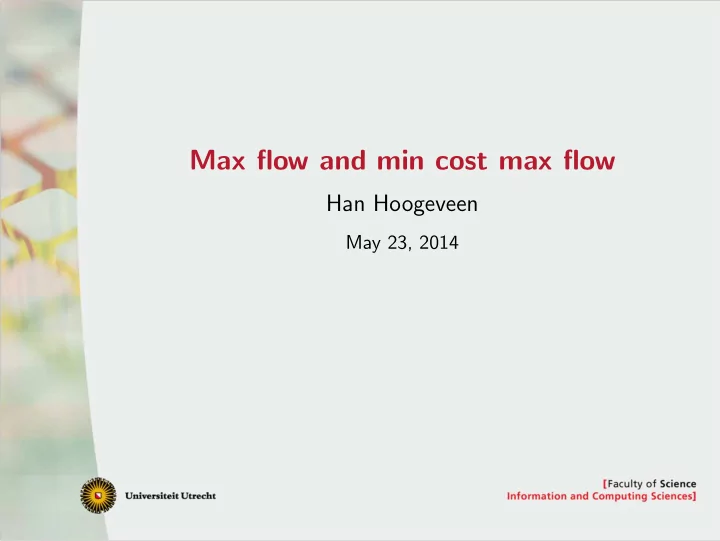

Max flow and min cost max flow Han Hoogeveen May 23, 2014
Basic problem description Given: directed graph G = ( V, A ) with special vertices s and t . ◮ The goal is to find a flow x from s (source) to t (sink) of maximum size. ◮ The flow x ij through arc ( i, j ) ∈ A must satisfy 0 ≤ x ij ≤ c ij ; here c ij is called the capacity of arc ( i, j ) ; there can be a positive lower bound on x ij . ◮ ‘Inflow=Outflow’: The total amount of flow entering v ∈ V \ { s, t } must be equal to the total amount of flow leaving v .
Basic solution algorithm: Ford-Fulkerson 1. Start with the zero-flow (feasible if all lower bound capacities are 0). 2. Given the current flow, find a path from s to t along which you can send flow (this is called an augmenting path). 3. Augment the flow by sending as much as possible along this s − t path. 4. Continue until you cannot find an augmenting path anymore.
Finding an augmenting path ♠ 1 � ❅ � 1 , 1 ❅ � ❘ ❅ 0 , 1 ✒ � ❅ � ❅ � ❅ 1 , 1 ❄ ♠ ♠ s t ❅ � � ❅ 0 , 1 ❅ ❘ � ❅ � ✒ 1 , 1 � ❅ ❅ � ♠ 2 Figure 1: (0 , 1) means: flow =0; capacity =1 How to proceed?
Residual graph Given the current flow x , construct the residual graph G = ( V, ˜ ˜ A ) . For each arc ( i, j ) ∈ A add to ˜ A ◮ arc ( i, j ) with capacity c ij − x ij (forward arc); ◮ arc ( j, i ) with capacity x ij (backward arc). An augmenting path corresponds to an s − t path in ˜ G ; its capacity is equal to the minimum capacity of its arcs in the residual graph. It is computationally efficient to use augmenting paths consisting of a minimum number of arcs. If the capacities are integral, then you find an integral flow.
Optimality proof ◮ The algorithm terminates if there is no s − t path in ˜ G . ◮ Define S as the set of vertices reachable from s ; let T denote the remaining vertices (including t ). ◮ This cut [ S, T ] splits the graph in two parts. All flow must go through arcs ( v, w ) with v ∈ S and w ∈ T . ◮ The capacity of the cut [ S, T ] is equal to the total capacity of the arcs ( v, w ) with v ∈ S and w ∈ T ; this is an upper bound on the size of the flow (this holds for any cut of G ). ◮ The size of the current flow is equal to capacity of the determined [ S, T ] cut. This proves the famous max-flow min-cut theorem.
Max flow min cost ◮ Extension of the max flow problem; ◮ Each arc ( i, j ) ∈ A has cost k ij . ◮ The cost of a flow x amounts to � k ij x ij . ( i,j ) ∈ A ◮ Goal: determine the cheapest flow of maximum size .
Max flow min cost (2) Same solution method. 1. Start with a min-cost flow of size 0. 2. Given the current flow, construct the residual graph ˜ G . The cost of arc ( i, j ) ∈ ˜ A is defined as � k ij if ( i, j ) ∈ A l ij = − k ji if ( j, i ) ∈ A. 3. Find the path in ˜ G from s to t with minimum length. 4. Augment the flow by sending as much as possible along this s − t path. 5. Continue until you cannot find an augmenting path anymore.
Initial flow ◮ A min-cost flow is a flow that has minimum cost within the set of flows of that size. ◮ A flow is a min-cost flow if and only if the residual graph contains no cycles with negative length. ◮ You can start with the flow x ij = 0 for each ( i, j ) ∈ A , unless the corresponding residual graph has cycles of negative length; if such cycles exist, then these have to be filled with flow first.
Example 3 ✲ ♠ ♠ 1 2 � ❅ � ❅ � � 0 ❅ ❅ 0 � ❅ ❘ � ❅ � ✒ ❅ 6 � � ❅ ❅ � ❅ ✒ � ❅ � ♠ ♠ s t ❅ � ❅ ❅ ❘ � � � ❅ ❅ 1 ❘ ❅ � � ❅ ❅ � ✒ 0 � � 0 ❅ ❅ ❅ � ❅ � ✲ ♠ ♠ 3 4 3 Figure 1: All arcs have capacity 1; the depicted figure is the cost How to proceed?
Remarks and extensions ◮ Successive augmenting paths do not get shorter. ◮ Instead of using Bellman-Ford (running in O ( n 3 ) time) you can use Dijkstra’s O ( n 2 ) algorithm for finding the shortest paths, after adjusting the lengths (Johnson’s algorithm). ◮ How to find the minimum cost flow with a given size? ◮ How to find the overall minimum cost flow? ◮ How to include lower bounds on the flow through the arcs? ◮ How to find a feasible flow that leaves b ( v ) units of flow in each vertex v ( b ( v ) can be negative)? ◮ How to find the maximum flow that leaves b ( v ) units of flow in each vertex v ?
Recommend
More recommend